Introduction
Currently, Runeterra has 1615 unique cards, which is a lot, but it's not that high when compared to Hearthstone, which has probably surpassed this mark a few years ago (it is really difficult to know exactly how many cards Hearthstone has).
Throughout these years, these two games shared several similar mechanics, such as Barrier and Divine Shield, Lifesteal and others. But some cards in these two games are literally identical, or extremely alike.
Let's see 10 LoR cards and their equivalent Hearthstone versions.
Ad
Avalanche & Consecration
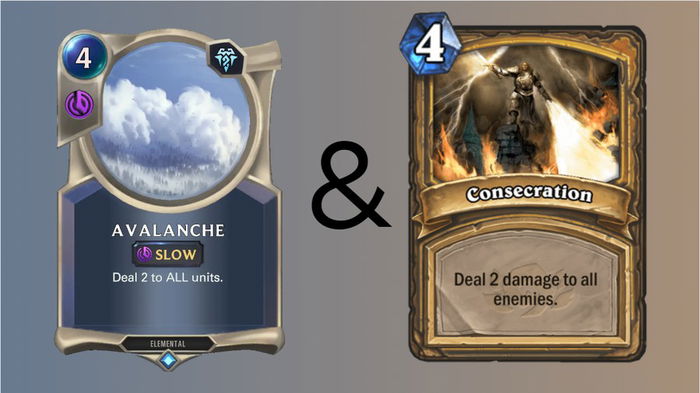
It is impossible to think about Avalanche and not think about Consecration as well. Both cards were played a lot in both games, and they were also released right away in these games' first set. Obviously, Avalanche is a direct reference to Consecration, considering it was created almost 7 years later. Still, both are considered very classic cards.
The most significant difference between them is that Consecration only deals damage to the opponent's board, and Avalanche deals damage to all units on the board.
Both have their own VFX, and Consecration's VFX is one of the most iconic effects in all of Hearthstone.
Even though Avalanche is a classic card in LoR, it hasn't seen a lot of competitive play in any format for a while because it is too weak, save for occasionally popping up in ramp lists.
Loyal Badgerbear & Spider Tank
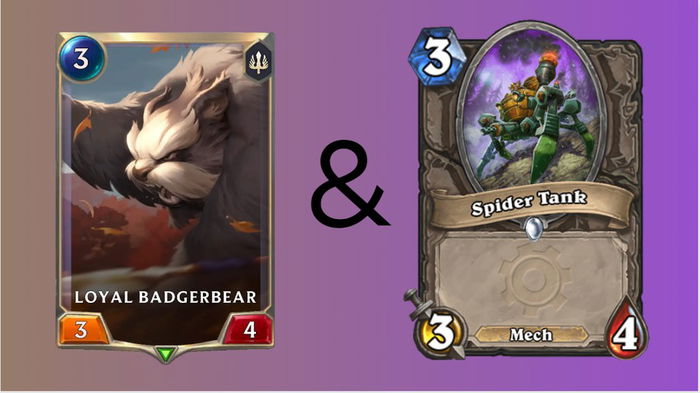
These cards are identical. Runeterra has a very limited number of cards with no effect at all, also called "vanilla" cards. As for Hearthstone, it released several "vanilla" cards during the years, particularly in this game's first 4 years, when basically at least one of these cards were released per set. Nowadays, this is quite uncommon for both games.
Loyal Badgerbear has never been a very popular card in Runeterra because, in the same set it was released, we had Grizzled Ranger, which summons a Loyal Badgerbear when it dies. So, we never had any incentive to indeed play this card. Even more recently, Blocking Badgerbear was released, and it is an improved version of Loyal Badgerbear - which is an example of the famous effect, "power creep".
As for Spider Tank, it is a card that was heavily played in the Goblins vs Gnomes set, but it wasn't that popular in other sets because the overall power of the cards increased, and it became more and more inefficient to have a unit with no effects in your deck.
The Ruination & Twisting Nether
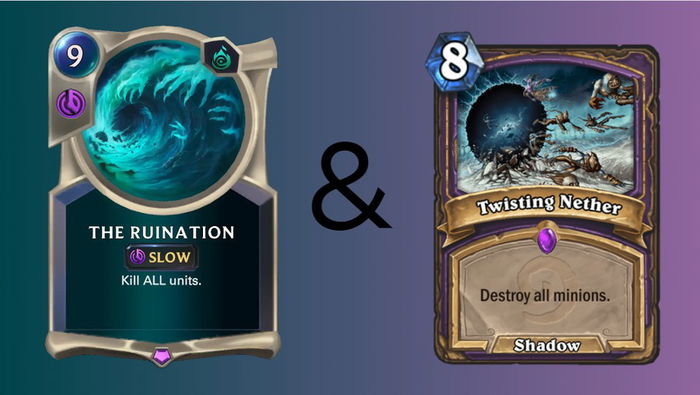
Twisting Nether is certainly one of the most iconic cards in Hearthstone. Actually, every card game has its version of a card that "removes the entire board", and Runeterra isn't different, as it has The Ruination.
Twisting Nether, just like Consecration, is 7 years older than The Ruination, so we can say it is a card that directly inspired LoR.
We can say Twisting Nether was more important to Hearthstone than The Ruination was to LoR because Twisting Nether was present in several metas, and has always been an extremely balanced and strong card in Warlock lists. This card saw play, and has always returned to competitive decks when the meta demanded it.
The Ruination, on the other side, was only popular in LoR's first few years, and was later limited to a 1-off in the few decks it played because it is too slow. To this day, it is not very popular, and it is relatively rare to see it in a deck even in casual lists.
Ad
Avarosan Sentry, Ceaseless Sentry & Loot Hoarder
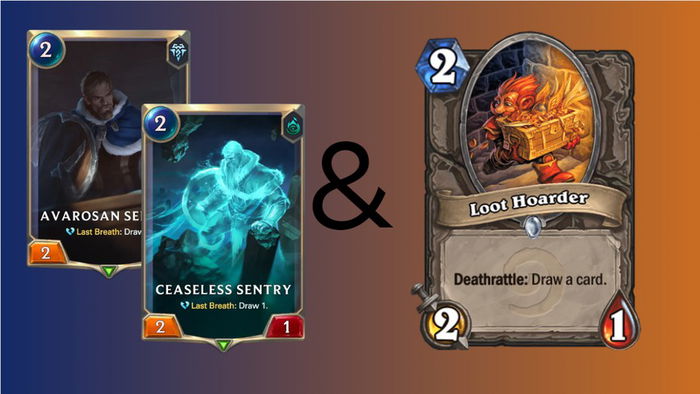
Loot Hoarder is probably one of the most played Hearthstone cards of all time. If I were to guess, I'd say this card could easily be included in a top 20 of the most used cards of all time. This card's concept is extremely solid, and matched practically any deck in its time, so much so that it was a minion that was used in almost all lists in the game's first sets.
This concept is so strong that Runeterra adopted it in two cards: Avarosan Sentry and Ceaseless Sentry, which is nothing more than Avarosan Sentry after he died.
Avarosan Sentry was rotated because it wasn't in Riot Games' plans for Freljord's region identity in 2023. However, considering it is a very cool and simple design, Riot recreated this card for Shadow Isles, for the happiness of all players.
It is difficult to compare Loot Hoarder with the Sentries because all three cards were very iconic in their respective times. But Loot Hoarder nowadays isn't that popular, and it has been a while since this card was forgotten because it is a bit too slow. As for Ceaseless Sentry, it is very popular in Shadow Isles lists, and even shows up in Mordekaiser lists.
So, we can say these cards' concept design survives to this day strong and solid in LoR, but in Hearthstone, it has been relatively left behind.
Kindly Tavernkeeper & Earthen Ring Farseer
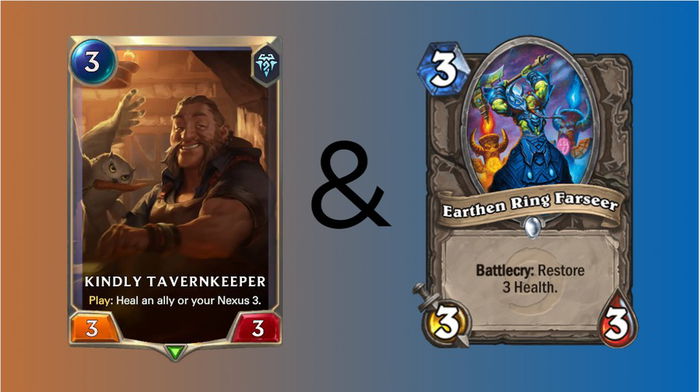
Once again, we have two identical cards, and both were in their respective card games' first card sets. Earthen Ring Farseer is one of my favorite Hearthstone cards, and I remember using it a long time ago. This card was played in the first Priest Control lists, and was also an excellent card in the Arena format. However, as time went on, this unit became obsolete and was forgotten.
As for Kindly Tavernkeeper, if it were in Standard, it would be one of the strongest cards in the entire game, and, alone, could destroy most aggressive decks in the game. This card was rotated precisely because of this: it is too strong.
During the Eternal competitive seasons, Kindly Tavernkeeper doesn't show up a lot because Aggro decks aren't very popular. However, they aren't very popular precisely because Kindly Tavernkeeper exists. So, if a Burn list becomes popular in this format, he will always be there to ruin aggressive players' fun. We can say that this card is the Runeterra meta's litmus test because it always shows up when we need it to.
Bull Elnuk & Chillwind Yeti
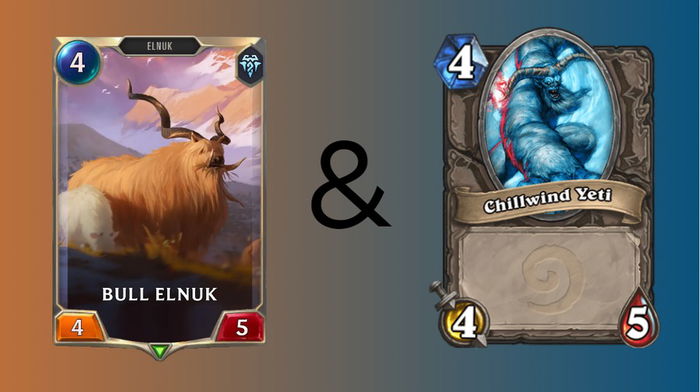
Guess what: more cards from these games' first sets - it even actually looks like Runeterra is copying Hearthstone!
This is the truth, and even LoR devs admit it. However, this is more seen as a way to honor and pay homage to this game, considering Hearthstone is the father of digital card games. Hearthstone cards' overall power is measured by the stats of its vanilla cards, which is the same method Runeterra uses to measure the strength of their own cards as well.
Ad
You might expect a unit with an effect to always have fewer stats than a vanilla unit with the same cost. We all know this isn't true, considering Blocking Badgerbear is much better than Loyal Badgerbear. This happens because the overall strength of the cards increases (or decreases) as time goes on, and can even depend on whether devs' interests change. Many times, a card will be released purposefully much stronger than others to fix a deficit in its class or region, or to highlight their strength.
In any way, Bull Elnuk's story doesn't even compare to Chillwind Yeti's story. Elnuks were only an archetype during Runeterra's beta period, but Chillwind Yeti was one of the best cards in Arena during Hearthstone's first few years, and was heavily played in Standard that time too.
Hearthstone has evolved and demanded units with effects, and this impacted all the vanilla cards in the game. However, it is easy to say that this particular card was the one that lasted the longest in the meta, and has been one of these cards with the most prestige.
Scaled Snapper & Druid of the Flame
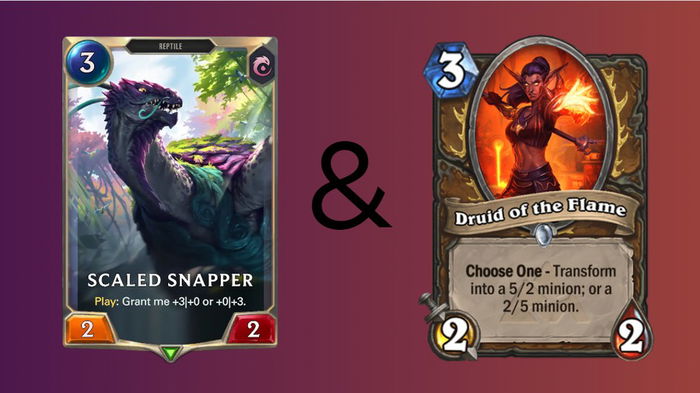
Druid of the Flame was released in the Blackrock Mountain set, and was used in Druid lists in the year it was revealed. Apart from this, it hasn't been a very popular card for this class. It came to reinforce the Choose One identity Druid has, and it did this well. To this day, this type of card is quite common, and we can say this design was a gigantic success for Hearthstone.
As for Runeterra, this style was a complete failure. Scaled Snapper has never even seen the color of a Runeterra board because it has never been played in any list, not even casually.
There is a big difference between these cards. Druid of the Flame transforms itself into a 5/2 unit or a 2/5 unit, and Scaled Snapper gains +3 attack or +3 health. Considering Transform is one of the strongest mechanics in Runeterra, if Scaled Snapper literally copied Druid of the Flame's text, it could be a playable card because it could play in Nidalee lists.
Cithria of Cloudfield & Enchanted Raven
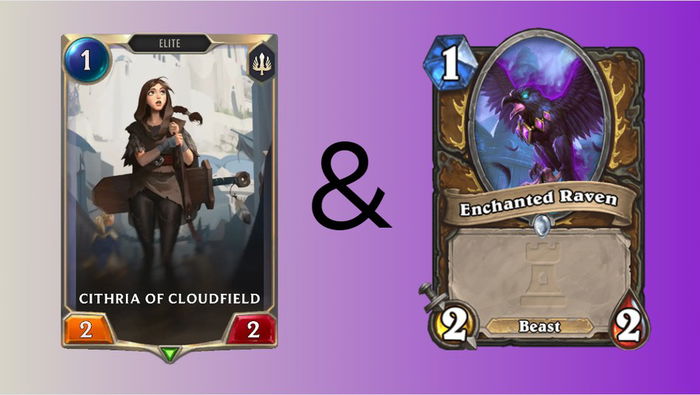
Enchanted Raven is another vanilla Hearthstone card. Unlike the others, it is a Class card, and was released in One Night in Karazhan. This means, that was the time vanilla cards started to become obsolete. This unit was well-used in aggressive Druid lists at the time, and was one of the first cards to feed this game style for the class that so far was known for the best Midrange decks in the game.
Cithria of Cloudfield, however, was a card released in Runeterra's first set, and had her moments in LoR's metagame history. It has never been a card that stood out, but it has always fulfilled its role of complementing a Midrange Demacia list because it was a consistent unit for turn 1. Currently, it briefly returned in Elder Dragon lists with Elites.
Ad
Nonetheless, Cithria of Cloudfield might be the most iconic card in all of Runeterra. It has several versions depicting Cithria herself in other Demacia cards, so we can keep up with her story from when she was a small recruit until she became Lady of Clouds, in her card, Cithria, Lady of Clouds.
She is also one of the cards that might become an exclusive champion in LoR in the future, and she is certainly very popular among players.
Final Words

If you've read this far, tell us in the comment section if there are any other Hearthstone cards that have a Runeterran sister!
Don't forget to share this article on social media. See you!
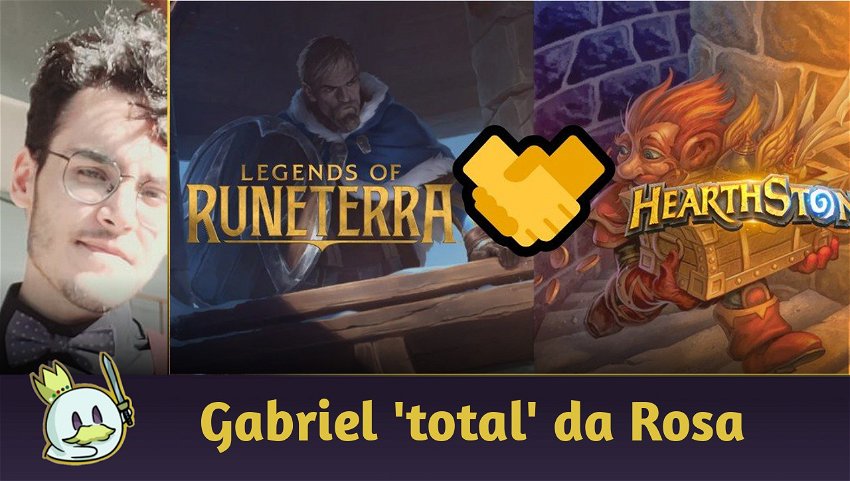



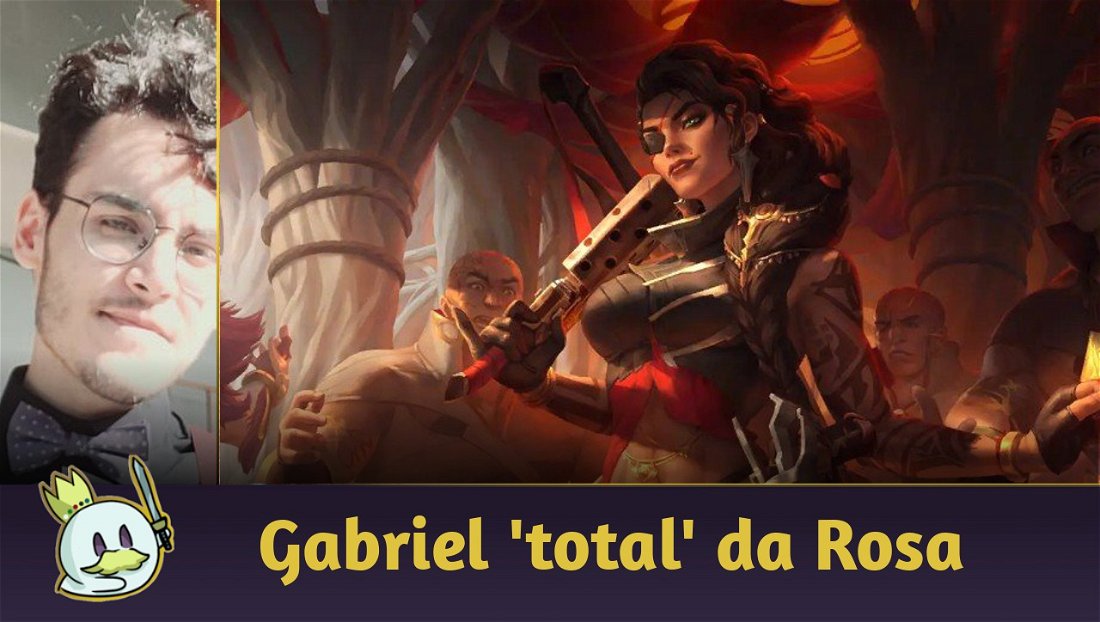
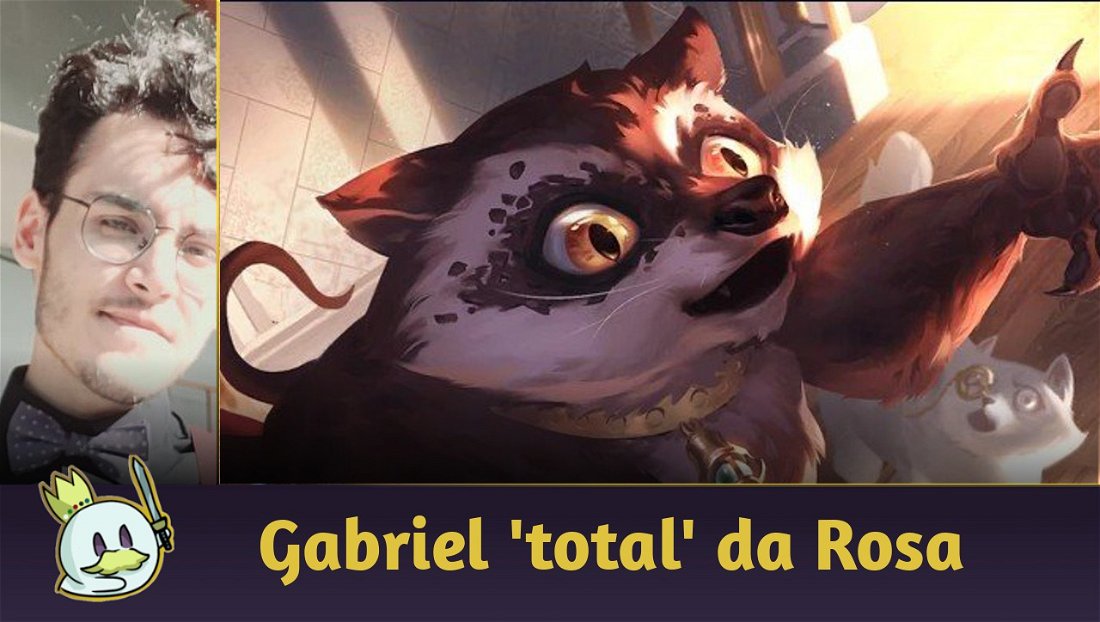



— Комментарии0
Прокомментируйте первым